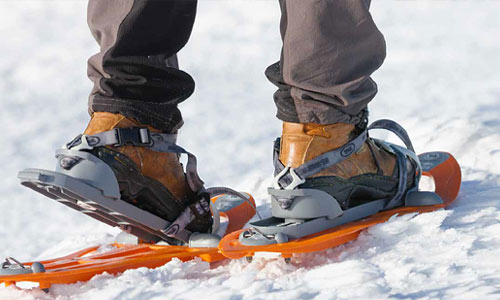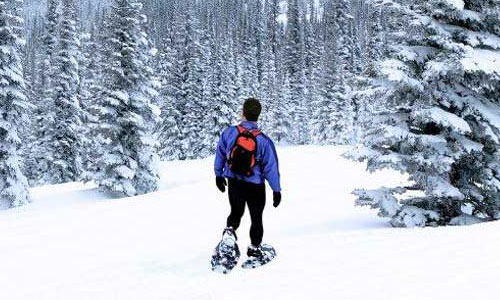Try Snowshoeing On Your Next Snow Adventure!
Author

Chris shares his passion for cycling, hiking, skiing, and climbing from Buxton, in the Peak District. As a blogger for Outdoor Look, Chris shares outdoor tips and indoor tricks to help you get the most out of your time spent outside. When he's not out adventuring he's making videos or trying to keep up with his 4-year-old son.
I love winter break as it provides me an opportunity to break free from my monotonous schedule and venture out in the open. As I live in Interlaken, which is located in the Bernese Oberland region of the Swiss Alps, I have easy access to the beautiful snowy peaks. Whenever I get time, I take off to the mountains, sometimes with family and sometimes solo.

Whenever I am alone, I prefer snowshoeing over other high octane activities like skiing. I rejoice in my solitary excursion as I take my time to explore its wonderful facets. Snowshoeing is easy to learn if you have the right tips and are prepared with the correct equipment. Below are a few pointers that I would like to bring to your notice, so that you can prepare yourself and make your snowshoeing adventure pleasurable.
1. Buying the Perfect Snowshoes
The most important part of snowshoeing, just like any other adventurous activity, is buying the right gear. There is nothing more significant than procuring the correctly sized snowshoes as per your body type. Weight plays an important part in selecting a pair of snowshoes. As the weight increases, the size of the snowshoe to be worn also increases. Make sure that you refer to a weight vs. size chart before buying your pair.
2. Dressing in the Right Clothes
Snowshoeing adventures are most enjoyable if you take your time and set out for a long journey. As you will be on the snow for a prolonged time, I advise that you wear customizable outfits to counter the changing weather. Convertible jackets, which can double up as a full sleeve and sleeveless jacket, can go a long way in helping you adapt to the ever changing weather. Make sure that your clothes are waterproof and have extra protection along seams to avoid water seepage into the jacket.
3. Preparation and Trekking Poles
Make sure that you buy trekking poles for a comfortable walk on snow. These poles provide stability and support when you are treading through a tough terrain.

If you are new to snowshoeing, it is advised that you over prepare yourself with extra food and water supplies, as your journey may take longer than anticipated.
4. Keeping your balance on snowshoes
For maintaining your balance while snowshoeing, I recommend that you stay upright and maintain a wider than normal stance. While turning I suggest that you lift your knee high, before turning towards the direction you intend to go to. By following this technique you will make sure that you don’t trip while making a turn.
If you are trying to avoid steep ascents and difficult terrains, then you can use a technique called traversing. For executing this method, you need to keep yourself on the elevated side of the hill, and plant your foot facing the uphill side on the snow and put all your weight on it. You can also shorten the adjustable poles facing the uphill side to maintain balance.
5. Going uphill and downhill
You need to follow specific techniques for snowshoeing uphill and downhill. I advise that you hire a trainer and let him guide you and prepare you for steep inclines and declines. I have always felt that taking short strides, especially when you are new to snowshoeing, really helps. Once you are well- versed with this activity, you will be able to dominate the field like a champ and explore the scenery with a new swagger.
Author

Chris shares his passion for cycling, hiking, skiing, and climbing from Buxton, in the Peak District. As a blogger for Outdoor Look, Chris shares outdoor tips and indoor tricks to help you get the most out of your time spent outside. When he's not out adventuring he's making videos or trying to keep up with his 4-year-old son.
- Speed Up Your Post-Hike Recovery with These 6 Essential Tips
- Cycling through Tranquil Roads and Coastal Views on the Isle of Wight
- The Essential Guide to Hiking Safety: 5 Tips Every Hiker Should Know
- Run Smart, Run Strong: Your Guide to Injury-Free Running
- Embrace Biking: Essential Tips for Beginners
Categories
- Sport (28)
- Product Reviews (3)
- Team Outdoor Look (7)
- Mike Wild (2)
- Mike Payton (2)
- Suse Hammond-Pears (3)
- Snowboarding (12)
- Latest Offers (105)
- Shop Talk (1)
- Competitions (7)
- Walking (413)
- Lifestyle Fashion (8)
- Travel (86)
- Kit Guides (176)
- Workwear Clothing (6)
- Safety Workwear (4)
- Health/Fitness (289)
- Skiing (91)
- Great Outdoors (1316)
- Cycling (92)
- January 2025
- December 2024
- November 2024
- October 2024
- September 2024
- August 2024
- July 2024
- June 2024
- May 2024
- April 2024
- March 2024
- February 2024
- January 2024
- December 2023
- November 2023
- October 2023
- September 2023
- August 2023
- July 2023
- June 2023
- May 2023
- April 2023
- March 2023
- February 2023
- January 2023
- December 2022
- November 2022
- October 2022
- September 2022
- August 2022
- July 2022
- June 2022
- May 2022
- April 2022
- March 2022
- February 2022
- January 2022
- December 2021
- November 2021
- October 2021
- September 2021
- August 2021
- July 2021
- June 2021
- May 2021
- April 2021
- March 2021
- February 2021
- January 2021
- December 2020
- November 2020
- October 2020
- September 2020
- August 2020
- July 2020
- June 2020
- May 2020
- April 2020
- March 2020
- February 2020
- January 2020
- December 2019
- November 2019
- October 2019
- September 2019
- August 2019
- July 2019
- June 2019
- May 2019
- April 2019
- March 2019
- February 2019
- January 2019
- December 2018
- November 2018
- October 2018
- September 2018
- August 2018
- July 2018
- June 2018
- May 2018
- April 2018
- March 2018
- February 2018
- January 2018
- December 2017
- November 2017
- October 2017
- September 2017
- August 2017
- July 2017
- June 2017
- May 2017
- April 2017
- March 2017
- February 2017
- January 2017
- December 2016
- November 2016
- October 2016
- September 2016
- August 2016
- July 2016
- June 2016
- May 2016
- April 2016
- March 2016
- February 2016
- January 2016
- December 2015
- November 2015
- October 2015
- September 2015
- August 2015
- July 2015
- June 2015
- May 2015
- April 2015
- March 2015
- February 2015
- January 2015
- December 2014
- November 2014
- October 2014
- September 2014
- August 2014
- July 2014
- June 2014
- May 2014
- April 2014
- March 2014
- February 2014
- January 2014
- December 2013
- November 2013
- October 2013
- September 2013
- August 2013
- July 2013
- June 2013
- May 2013
- April 2013
- March 2013
- February 2013
- January 2013
- December 2012
- November 2012
- October 2012
- September 2012
- August 2012
- July 2012
- June 2012
- May 2012
- April 2012
- March 2012
- February 2012
- January 2012
- December 2011
- November 2011
- October 2011
- September 2011
- August 2011
- May 2010
- April 2010
- March 2010
- February 2010
- January 2010
- November 2009
- October 2009
- September 2009
Submit a Comment